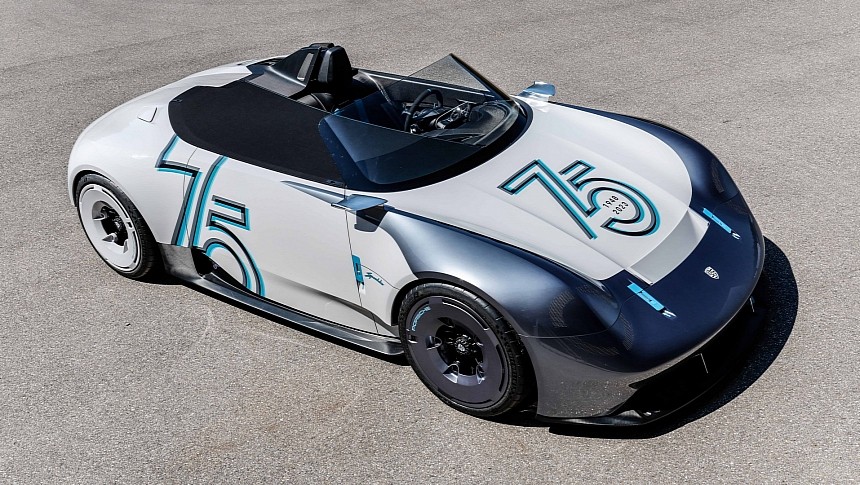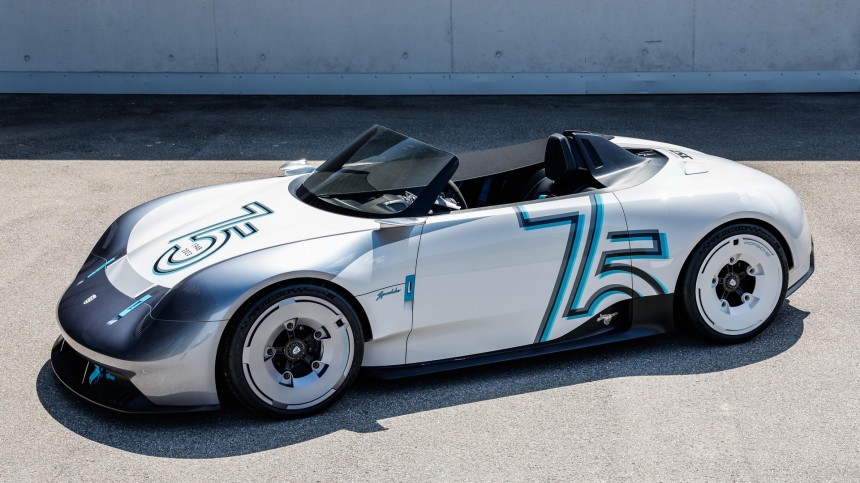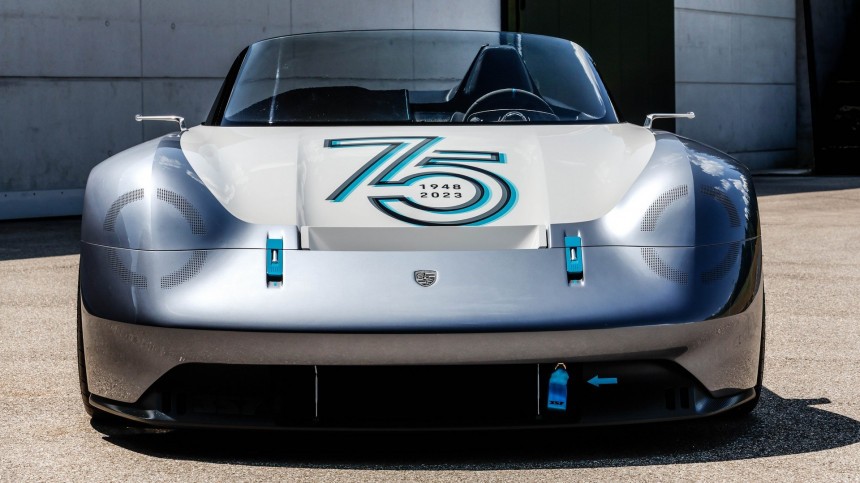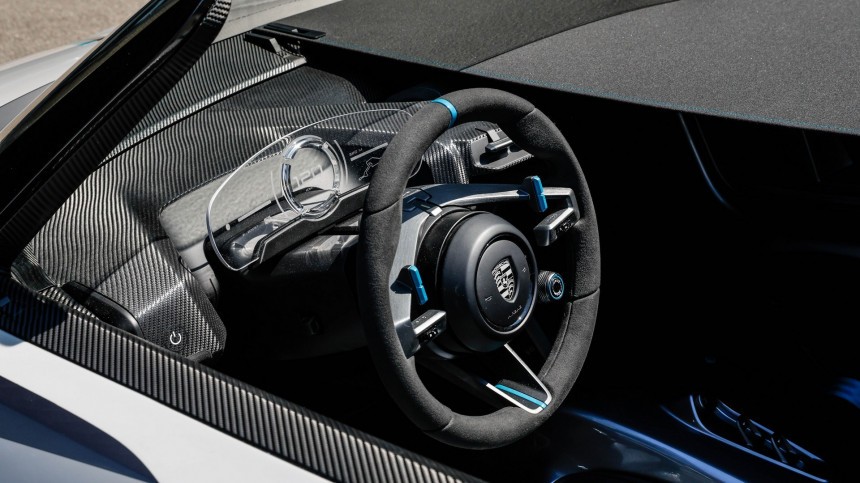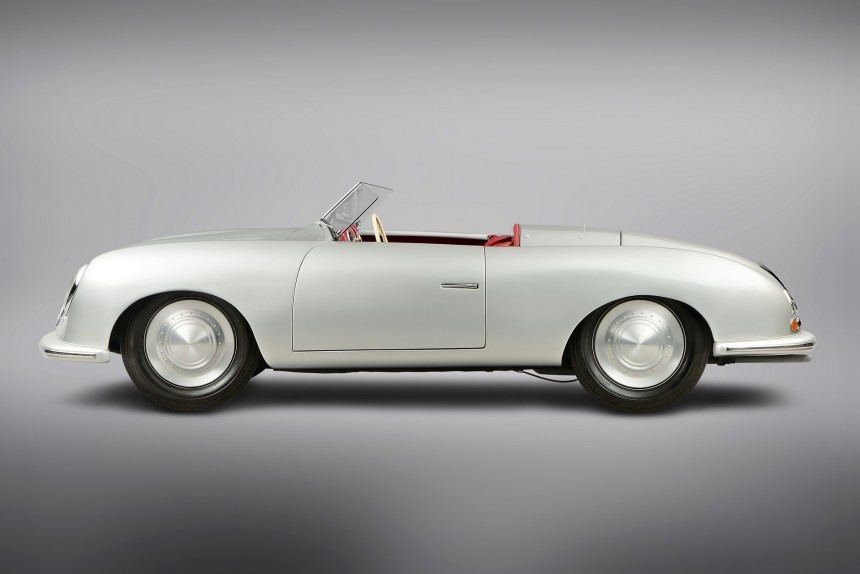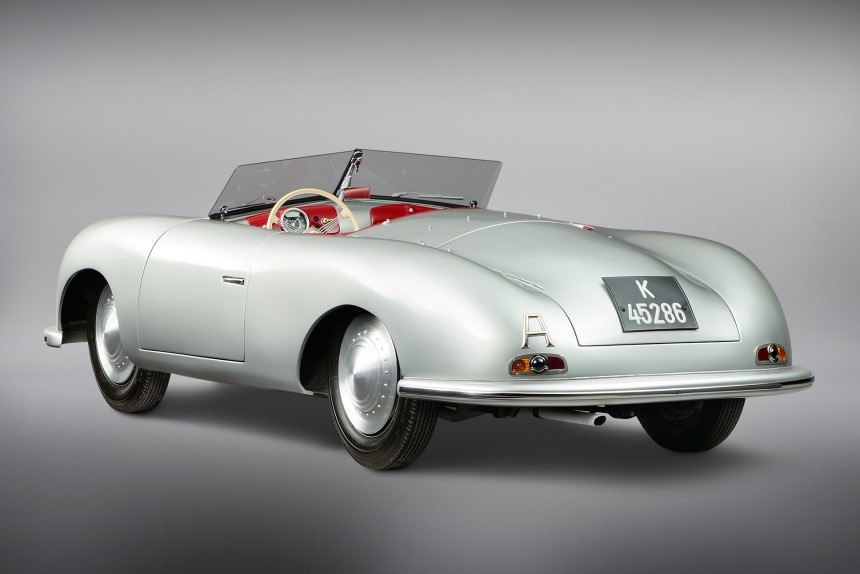Porsche knows how to celebrate and praise grand events from the realm of motorsports, especially when milestone anniversaries call for impeccable piston manners. The Goodwood Festival of Speed turns 30 this year, and the German sportscar company masterfully lauds this moment with the Porsche Vision 357 Speedster. It is a concept car – the roofless sister model of the hardtop Porsche Vision 357 that declared open Porsche’s own celebrations for the carmaker’s 75th anniversary.
Does the “357” moniker sound familiar, but you can’t quite put your finger on it? Subtract one from the number, and the result is the emblem on the first Porsche sportscar, the 356. Indeed, the Goodwood FOS is a hat-tip to the quintessential German sportscar, the 1948 dream-come-true of Ferry Porsche.
The Vision 357 Speedster is rooted (technologically) in the Porsche 718 GT4 e-performance, with the electric propulsive system (motors and battery) from the Mission R grafted onto a 718 GT4 Clubsport chassis.
After this premiere at the English Festival, the concept will make a second appearance at the American Rennsport Reunion in late September. The design study Porsche Vision 357 retains the crouched, shortened windscreen in genuine speedster fashion.
A tonneau cover – a node to open-top sports cars from eight decades ago – spreads over the passenger side. The carbon-made concealed roll bar behind the driver supports the floating headrest. Behind the roll-over head-protecting hump sit the charging inlet and the anchor for the car’s top (see it in the video).
The concept is liveried in a dual-tone shade of gray - Marble Grey and Grivelo Grey Metallic – that hints at the early motoring racing heroes, with their protective front fenders that shielded the wheels from rocks thrown by other competitors. The graphics on the car contain comic-style unicorns in front of the rear wheels – a bespoke drawing from Porsche designers.
The apparent lack of side mirrors is due to rearview video cameras placed on the fenders (not on the door, outside of the upper hinge) – another bow to classic race cars from years ago. The camera pods are housed in a wing-resembling aerodynamic element.
The round headlights are sectioned in individual quarter-circle arches. At the same time, the rear lamps hide behind an arrangement of drill holes made directly into the body panels. The vertical lines running along the back side, from behind the cockpit to the rear diffuser, evocate the air intake of the original Porsche 356 from 75 years ago. The stylized grille on the concept integrates the third brake light.
The 357 sits on 20-inch magnesium wheels flexing on a wide track, further emphasized by the car’s naturally-low roadster stance that improves stability. The wheels have carbon fiber hubcaps with center locks. The hubcap-mimicking wheel covers harken back to the 8-inch (20.5 cm) bolt circle that ornated the Porsche 356 A and 356 B wheels.
The cockpit is bare-necessities minimalistic, with a ground-tickling low driving position. The carbon-fiber-reinforced plastic seat shell is imbued in the monocoque. Six-point seat belts grasp the driver; the instrumentation is reduced to a transparent and tastefully discrete display floating on the steering column right behind the wheel.
Inspired by the racing steering wheels that led so many Porsches to grand victories over the decades, the 357’s helm is light, with simple commands spread across the two horizontal spikes. The carbon-weave pattern covers the dash, with blue straps as temporary storage for accessories instead of the usual glove box. Also, the door handles consist of nothing more than textile ribbons (yet another feature derived from the weight-saving innovations allotted to racing cars).
While the conceptual Porsche 357 is undoubtedly the star of the maker’s delegation at FOS, it is in a select company. The first Porsche 356 ever assembled is one of the icons from the Stuttgart manufacturer, the historical 356/1 roadster. Alongside the emblematic two-seater sits the one-millionth 911 built, a one-off Carrera S from the 991 generation.
Porsche’s parading history wouldn’t be complete without the company’s grandest racing heroes from Le Mans. Three class winners and three overall winners (from 1961, 1976, ’81, ’98, 2017, and 2018) of the world’s most famous endurance race will roll aside the Porsche 357 Vision.
Six Porsche automobiles will march up and down the hill at Goodwood two times a day – the 356/1 Roadster, a 928 race car from ’83, the 911 No: one Million, a 959, a Turbo S (993), and a Cayenne Transsyberia.
The foundation of this year’s pair of 357 Vision concept cars is the Porsche 356 – in both its pure prototype roadster shape and the classic, world-famous, symbolic coupe profile. The German company holds the date of June 8, 1948, to very high praise. On that day, the 356/1 prototype was issued the general operating permit.
Based on Ferry Porsche’s design, the first Porsche car was assembled in Austria at Gmünd. The aluminum body sits on a steel lattice tube frame – both Porsche’s concept and execution. The mechanicals were donated by Volkswagen (altered to suit Porsche’s needs).
Unlike a host of its offspring, the first Porsche was a veritable mid-engined sportscar with a four-cylinder boxer in front of the rear axle. The small horizontally-opposed plant was a meager 1.13-liter air-cooled engine that was only capable of delivering 35 hp and 135 kph (84 mph).
The engine-between-the-axles-architecture idea was scrapped to make room for a second row of seats, which pushed the flat-four beyond the rear axle. The No. 1 Roadster remained a one-of-one automobile. Apart from the increased occupant capacity, the production version also had a shell made out of steel.
The Vision 357 Speedster is rooted (technologically) in the Porsche 718 GT4 e-performance, with the electric propulsive system (motors and battery) from the Mission R grafted onto a 718 GT4 Clubsport chassis.
After this premiere at the English Festival, the concept will make a second appearance at the American Rennsport Reunion in late September. The design study Porsche Vision 357 retains the crouched, shortened windscreen in genuine speedster fashion.
The concept is liveried in a dual-tone shade of gray - Marble Grey and Grivelo Grey Metallic – that hints at the early motoring racing heroes, with their protective front fenders that shielded the wheels from rocks thrown by other competitors. The graphics on the car contain comic-style unicorns in front of the rear wheels – a bespoke drawing from Porsche designers.
The apparent lack of side mirrors is due to rearview video cameras placed on the fenders (not on the door, outside of the upper hinge) – another bow to classic race cars from years ago. The camera pods are housed in a wing-resembling aerodynamic element.
The 357 sits on 20-inch magnesium wheels flexing on a wide track, further emphasized by the car’s naturally-low roadster stance that improves stability. The wheels have carbon fiber hubcaps with center locks. The hubcap-mimicking wheel covers harken back to the 8-inch (20.5 cm) bolt circle that ornated the Porsche 356 A and 356 B wheels.
The cockpit is bare-necessities minimalistic, with a ground-tickling low driving position. The carbon-fiber-reinforced plastic seat shell is imbued in the monocoque. Six-point seat belts grasp the driver; the instrumentation is reduced to a transparent and tastefully discrete display floating on the steering column right behind the wheel.
While the conceptual Porsche 357 is undoubtedly the star of the maker’s delegation at FOS, it is in a select company. The first Porsche 356 ever assembled is one of the icons from the Stuttgart manufacturer, the historical 356/1 roadster. Alongside the emblematic two-seater sits the one-millionth 911 built, a one-off Carrera S from the 991 generation.
Porsche’s parading history wouldn’t be complete without the company’s grandest racing heroes from Le Mans. Three class winners and three overall winners (from 1961, 1976, ’81, ’98, 2017, and 2018) of the world’s most famous endurance race will roll aside the Porsche 357 Vision.
The foundation of this year’s pair of 357 Vision concept cars is the Porsche 356 – in both its pure prototype roadster shape and the classic, world-famous, symbolic coupe profile. The German company holds the date of June 8, 1948, to very high praise. On that day, the 356/1 prototype was issued the general operating permit.
Based on Ferry Porsche’s design, the first Porsche car was assembled in Austria at Gmünd. The aluminum body sits on a steel lattice tube frame – both Porsche’s concept and execution. The mechanicals were donated by Volkswagen (altered to suit Porsche’s needs).
The engine-between-the-axles-architecture idea was scrapped to make room for a second row of seats, which pushed the flat-four beyond the rear axle. The No. 1 Roadster remained a one-of-one automobile. Apart from the increased occupant capacity, the production version also had a shell made out of steel.
